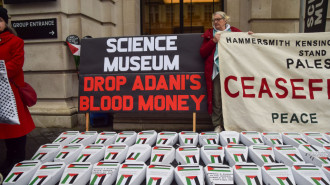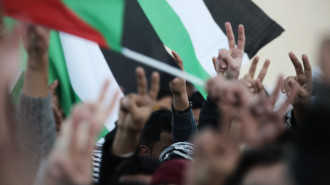
'This is cultural suicide': Iraqis condemn UNESCO-sanctioned reconstruction of Mosul’s al-Nuri Mosque

Four years after Mosul’s iconic al-Nuri Mosque crumbled in the war against the Islamic State group (IS), its long-awaited reconstruction is finally underway. The obliteration of the mosque’s much-vaunted, 850-year-old minaret, otherwise known as the “hunchback,” was a particularly sobering loss.
The mammoth task will be carried out by a team of Egyptian architects, led by Salah El Din Hareedy, after winning the UNESCO-sponsored, Emirati-funded international Nuri Mosque design competition, launched last year.
Their winning “Courtyards Dialogue” design appears to have attracted an upswell of critical commentary and polarised public opinion inside and outside of Iraq. Concerned citizens, historians and intellectuals have been coalescing to oppose the design’s commercial aesthetic, which they view as an affront to Mosul’s architectural and cultural identity.
The contention is that the replacement of the original mosque with an inauthentic replica would amount to cultural suicide
The main charge is that the architectural style of the proposed complex does not faithfully represent the original layout. Other critics have gone further, suggesting that the winning architectural team have reinvented the cultural space in their own, distinctly-modernist image, reminiscent of Gulf cityscapes.
Specialists have also argued that the winning submission flouts the basic requirement — as the design brief stated — that reconstruction “will follow entirely” the mosque’s pre-2017 dimensions and features.
|
© UNESCO/Salah Hareedy; Khaled El-Deeb; Sherif Ebrahim & Tarek Ali Mohamed |
Professor of architecture and urban conservation, Ihsan Fethi — who has laboured since the 70s to document Mosul’s built heritage — denounced the exaggeratedly modernist revamp as the “undoing” of Mosuli culture. Along with other critics, Fethi has questioned the choice of cubist architecture, the reconfiguration of the mosque’s courtyard, the absence of its infamous gardens, and incongruous ornamental details, such as date palms and English language inscriptions on the building exterior. As one user lamented, “who are they building this for?” whilst another asked, “do you see Mosul’s identity?”
Fethi is not alone. The growing camp of dissenting Iraqi voices also features the Iraqi Architectural Heritage Society, the Iraqi Engineers Union, the Mosul-based Yusef Thanoun Centre for historical and artistic studies, Iraq-based architectural firms, and esteemed artists including Iraqi painter and sculptor, Dia Azzawi.
The main contention is that the replacement of the original mosque with an inauthentic replica would amount to cultural suicide.
In affirmation of this stance are slogans that have been widely shared including, “build it as it was'', “Mosul doesn’t need a new mosque” and “stop faking Mosul” which together expose the hazy line between reconstruction and reinvention.
"The plan wasn’t to re-build the al-Nuri mosque, but to educate people about how to respect each other, as if the people of the ancient city know nothing about tolerance and coexistence"
Inside Mosul, seminars have been organised by the Yusef Thanoun Centre whose members urged attending UN officials, including project director, Rakan Al-Allaf, to revise the design in a manner safeguarding the historical specificity and continuity of the 12th century site.
Professor of Islamic Architecture and Heritage, Ahmed Qassem Juma, urged the cultural arbiter to restore the old Nouri school and the western, Mamluk-era entrance, to their former selves, replete with the original inscriptions, engravings, and material and brick masonry.
Al-Allaf assured locals that the winning design “is preliminary” and would be subject to revisions, implemented, as he insisted, only in partnership with a local Mosul designer and/or architectural firm, “to achieve the best results”.
No changes to the design have been announced by Al-Allaf or UNESCO, and public anxiety and anger over the fate of the mosque, have continued to simmer in the absence of action.
One Mosul-native who fled his city at the height of the war and has since put down new roots in Doncaster where he studies digital architecture, expressed disappointment. “They haven’t captured Mosul’s identity or satisfied the reconstruction requirements,” he told The New Arab. “The plan wasn’t to re-build the al-Nuri mosque, but to educate people about how to respect each other, as if the people of the ancient city know nothing about tolerance and coexistence,” he said.
“This wasn’t a project for the people. It’s more like a ‘yes-the-UAE-did-it’ project. But the people want restoration. They don’t want alterations, additions or modifications. They just want it to look as it did before the war,” he said.
"This wasn’t a project for the people. It’s more like a ‘yes-the-UAE-did-it’ project. But the people want restoration. They don’t want alterations, additions or modifications. They just want it to look as it did before the war"
Other critics believe that funding by the Emirates has brought the Iraqi government’s silence, who, alongside the Sunni Waqf, have not responded to local reactions.
|
Mosuli activist, Tahany Saleh, has been appealing to the UN to initiate a week of dialogue to bring the local community into conversation with international decision-makers. A similar request that had been submitted to UNESCO’s Iraq director, Paolo Fontani, by the Iraqi Engineers Union, fell on deaf ears.
This perceived exclusion has fuelled a dour public mood, as well as distrust of UNESCO in its position as the sole arbiter of Iraqi culture.
On the other end of the opinion spectrum are voices of optimism, such as Mosuli historian and ‘Mosul Eye’ blogger, Omar Mohammed.
Mohammed praised the reconstruction effort, and its leading patrons, Sheikh Mohammed bin Zayed, and UNESCO, and rejoiced the fact that talk of architecture had replaced headlines about IS terrorism, adding that people have “the full right” to like or dislike the design.
On 10 May 21, UNESCO-hosted an online webinar called A Landmark Reimagined, in which speakers addressed some of the concerns voiced. In an implicit rebuttal to claims regarding the building of a “new mosque”, Iraq-born, UAE-based architect, Raya al-Ani (also the President of the Jury for the al-Nuri Mosque competition) underlined the absence of surviving records and detailed architectural drawings that she said made it impossible to build an exact replica.
[It is] a project which carries much more than its hefty $50 million dollar price-tag; ultimately the responsibility to restore Mosul’s heart and soul
She stressed that consensus on the matter had been reached in consultation with Mosul's heritage experts, including Professor Jumaa, who had been involved in the eight-month-long initial research phase. Al-Ani described the choice of the Courtyards Dialogue project as the best design solution, intended to illuminate, preserve and accentuate the symbolic aspects of the site; “it is not,” she emphasised, “about returning,” in reference to Mosul’s unrecoverable past.
Assurances have been made, but have public fears been allayed? Opposition is likely to snowball. As likely, is the march towards the project’s implementation — a project which carries much more than its hefty fifty million dollar price-tag; ultimately the responsibility to restore Mosul’s heart and soul. Whether or not people come around is a question that can only be answered once a new mosque is stood in place of the pre-2017, al-Nuri mosque.
Nazli Tarzi is a freelance British-Iraqi journalist specialising in Middle East politics, with a particular interest in Iraqi affairs.
Follow her here: @NazliTarzi
![The proposed "cubist" design of Al-Nuri Mosque has angered Mosul residents [© UNESCO/Salah Hareedy; Khaled El-Deeb; Sherif Ebrahim & Tarek Ali Mohamed]](/sites/default/files/styles/medium_16_9/public/2021-05/al-nouri-mosque-reconstruction-mosul-iraq-unesco_dezeen_2364_col_1-852x479.jpg?h=9d59c0d4&itok=YnF5IVMU)


